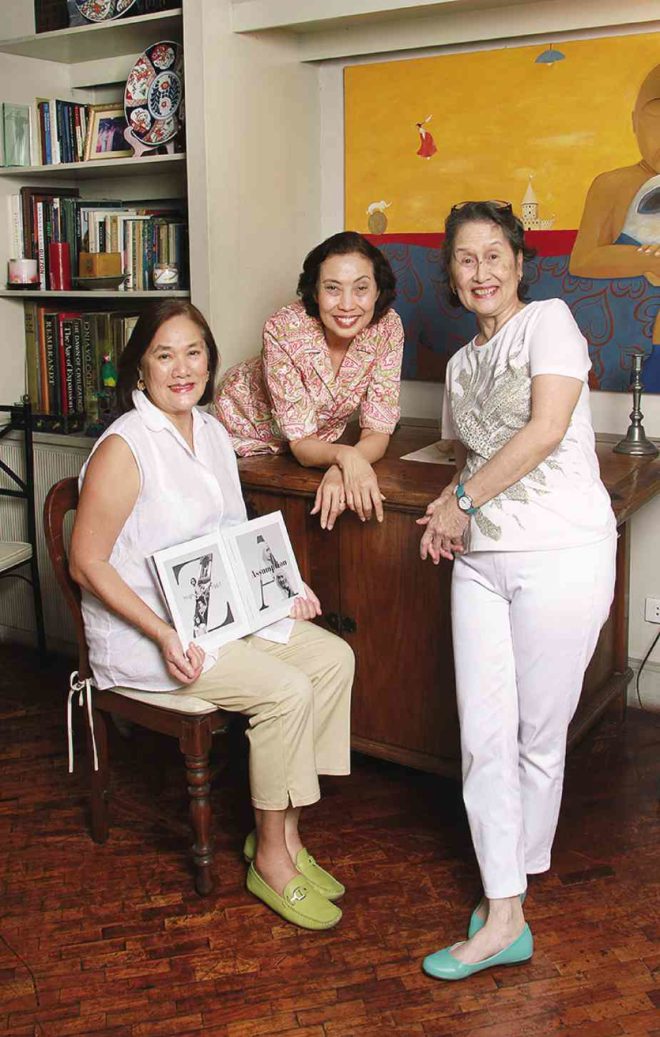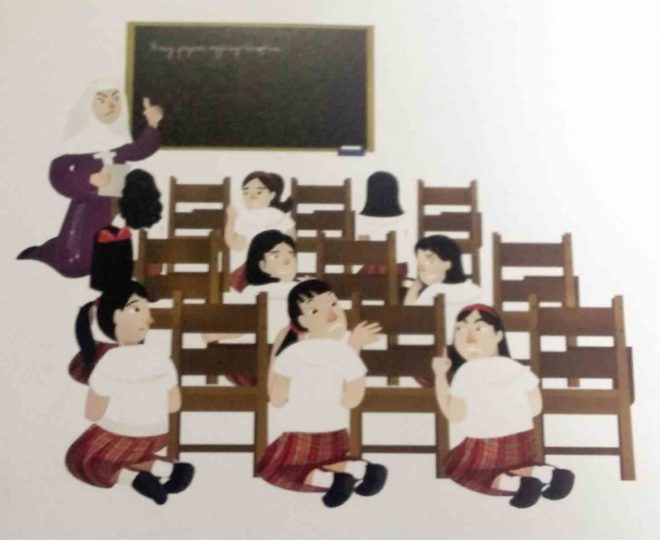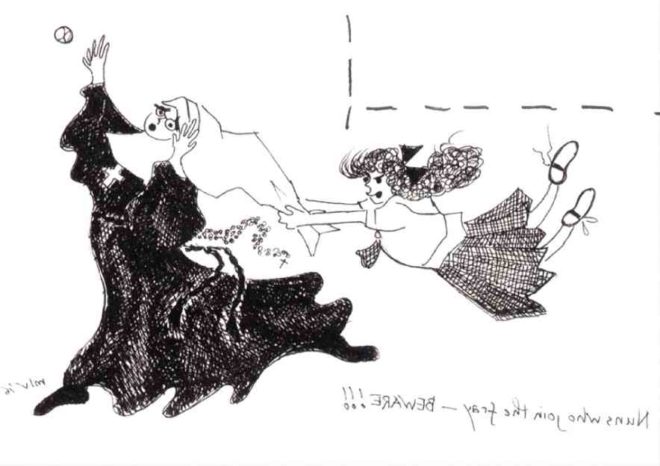
Sitting behind their desks, the two French nuns wore the same look on their faces: stoicism. Sensing she was in trouble, the student stood trembling as the nuns shook their heads while exchanging comments in French.
Assumption College alumna Maria Lourdes de Vera recalls the Lecture (French word for “reading”) of Notes. It was a periodic assessment of the student’s grades and behavior, given by the Mother Superior and the Mistress of Class (a nun who supervised the students). Reading their notes, they pointed out the students’ lack of focus and discipline and serious misconduct.
However, the Mother Superior would soften the “blow” by saying positive comments in the end.
In mid-20th century Assumption, the Mistress of Class was like a mother and disciplinarian. While students knelt, she led prayers at 7:20 a.m., and conducted the Morning Talk, which consisted of announcements, reprimands and reports on the latest accounts in the dire Observation Notebook. It recorded the students’ offenses such as talking in class or wearing their uniform in a public place.

Historical nuggets
“You never got away with anything. Crime didn’t pay; I was punished all the time,” says Cristina Ansaldo Estrada, De Vera’s batchmate and former Assumption professor. The Mistress of Class would send Estrada to a corner and make her write an ejaculation, a short prayer that was repeated a hundred times.
Sometimes, the errant student was made to memorize a chapter from the Gospel of St. Mark.
These historical nuggets are captured in “Assumption A to Z,” a picture book that alphabetically defines the Assumption College’s heritage. To commemorate its 50th jubilee year, high school class 1967 published and wrote this homage to its alma mater.
Entrepreneur and jubilarian Concepcion Poblador and her batchmates presold the book to finance the project.
More than a nostalgic tribute to the alumni’s student days and to memories that make Assumption unique, the book provides interesting tidbits of cultural history in the last century.
“The book shows how France first gained its foothold in the Philippines through the Assumption Order—not the French ministry nor Alliance Francaise,” comments journalist Amando Doronila. “The Assumption Order is a cultural influence that has sunk deep.”
De Vera and the team gathered materials from libraries and old Assumption yearbooks and interviewed alumni.
The book pays reverence to French founder Sister Marie Eugénie Milleret and her formation of the Congregation of the Religious of the Assumption in Paris in 1839. Her group advocated teaching Christian principles to uphold society’s values. She was later canonized as St. Marie-Eugénie de Jésus for her apostolic work and dedication to God.
In 1892, the Spanish government decreed that a women’s school for teachers be put up in the Philippines. Queen Regent Maria Cristina of Spain appointed the Religious of Assumption to run the school. It provided an opportunity for the residents in Manila to send their children to a school with European standards.

Royal decree
De Vera met historian Fr. Fidel Villaroel, head of the University of Santo Tomas archives, last August while doing research for the book. She requested a copy of the 19th-century Spanish periodical Gaceta de Manila, which published the royal Decree to establish the Superior Normal de Manila, led by the Assumption nuns.
On her return last January, De Vera learned that Father Villaroel had died in December. Nonetheless, he had left the Gaceta with the librarian.
When the Spanish-American war disrupted school operations, the nuns went back to Europe. During the American regime, English-speaking Assumption Sisters re-established the school in Herran (now Pedro Gil) Ermita. But the school and most of Manila were destroyed by bombings in 1945.
Classes resumed in Quonset huts—makeshift, semicircular buildings made of galvanized iron sheets, a far cry from the Gothic Revival architecture of the original Assumption. The reconstructed Herran campus operated from 1948 to 1973 until the property was sold to a major developer.
The book describes many elements that are distinctively Assumption, such as the recipe for the Assumption tart, a triangular biscuit with guava jelly, served on special occasions; the round, European lace collar draping the gala uniform; the plaid skirt that was originally imported from Europe; the cursive penmanship; and the Old Girls’ Day or the annual homecoming which celebrates Assumption traditions.
‘Maarte’ stereotype
De Vera nixes the “maarte” Assumptionista stereotype. Back then, the girls played rough games during their recreation or break time. The aim of war ball was to eliminate the opposing team by hitting each member with a volleyball. The challenge was to dodge the ball or catch it and throw it back at the opponent.
In bataille, two opposing teams blocked each other off to vie for the tennis ball. When the nuns joined them, the girls would naughtily pull their veils.
Then there were religious customs such as the Adoration, wherein three representatives from each class were given schedules to kneel for 15 minutes in front of the Blessed Sacrament.
The students took their meals in the refectory (in place of a cafeteria.) The girls filed in silence and sat on assigned chairs. Silence was observed, only to be broken by prayers and the nun’s clap to signal the start and end of a meal. If a girl didn’t finish her meal, the misconduct was logged in the Observation Notebook.
During Lent, a nun read spiritual literature or a homily. “In those days, we knew all the names of the saints,” says Estrada.
The Mistresses of Class held a special place in the students’ heart.
“They were strict but affectionate. They took a personal interest in you. If you got sick, the nun would bring you to the infirmary and call your mother. They wouldn’t allow anyone else to pick up the students except the parents,” says Estrada.
“We knew when the nuns were approaching. We could hear the swishing of the beads of their rosaries. We hid. One of the nuns knew that, so she held the rosary so that it wouldn’t make noise,” recalls De Vera.
Interesting custom
One of the interesting customs was the “permission,” a piece of wood found near the door or the teacher’s desk. It was the student’s “passport” to leave the class and go to the restroom without interrupting the teacher’s lecture.
But some students from Herran abused the “permission” by chatting with friends along the corridors, oblivious to their classmates who needed to go to the restroom. Others went to Acme Supermarket, or visited their friends at Assumption San Lorenzo.
By today’s standards, some the practices may seem rigid. But to the jubilarians, they were a veritable rite of passages.
“All the ‘craziness’—I look back at them with fondness,” says Estrada.
De Vera adds, “In our Flower Power years, we experimented with different philosophies. In the end, I went back to the faith that was already there.”
How is the book relevant to the millennial generation? According to Poblador, “Aside from its excellence in graphic design, it has good historical research. There are many things about the history of our school and its French roots, and its role in Philippine education, that we are not aware of. Surely the type of education that has produced two female presidents—Corazon Aquino and Gloria Macapagal-Arroyo, with all their flaws—merits a second look.” —CONTRIBUTED








































